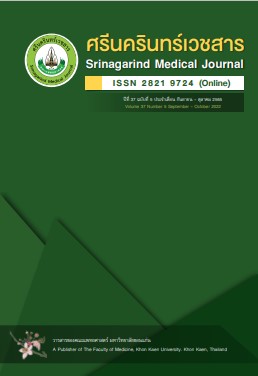ผลของการฝึกการทรงตัวด้วยเครื่องสะท้อนกลับจากแรงกดฝ่าเท้าในผู้ป่วยโรคหลอดเลือดสมอง : การศึกษาแบบสุ่มและมีกลุ่มควบคุม
The Efficacy of Additional Force Platform Biofeedback Training on Balance in Chronic Stroke patients: A Randomized Controlled Trial
Abstract
หลักการและวัตถุประสงค์:โรคหลอดเลือดสมองทำให้เกิดความพิการในกลุ่มประชากร ปัจจุบันมีการนำเทคนิคสะท้อนกลับมาใช้ในการฝึกฟื้นฟู การศึกษานี้จึงมีวัตถุประสงค์เพื่อศึกษาผลของการฝึกการทรงตัวด้วยเครื่องสะท้อนกลับด้วยแรงกดที่ฝ่าเท้าในผู้ป่วยโรคหลอดเลือดสมองระยะเรื้อรัง
วิธีการศึกษา: การศึกษานี้เป็นการทดลองแบบสุ่มและมีกลุ่มควบคุมโดยปกปิดสองทาง ในอาสาสมัครโรคหลอดเลือดสมองระยะเรื้อรัง จำนวน 29 ราย โดยใช้วิธีการสุ่มเข้ากลุ่มทดลอง 16 ราย และกลุ่มควบคุม 13 ราย ทั้ง 2 กลุ่มได้รับการฟื้นฟูทางกายภาพบำบัดแบบดั้งเดิม ครั้งละ 45 นาที จำนวน 3 ครั้งต่อสัปดาห์ เป็นเวลา 4 สัปดาห์ กลุ่มทดลองได้รับการฝึกด้วยเครื่องสะท้อนกลับด้วยแรงกดที่ฝ่าเท้า 20 นาทีต่อครั้ง 3 วันต่อสัปดาห์ เป็นระยะเวลา 4 สัปดาห์แล้วตามด้วยการฝึกกายภาพบำบัดแบบดั้งเดิมตัวแปร ในการศึกษาได้แก่ ความสามารถในการทรงตัวประเมินโดย Berg balance scale (BBS) และความเสี่ยงต่อการล้มประเมินโดยTime up and Go test (TUG) โดยประเมินก่อนและหลังได้รับโปรแกรมการรักษา
ผลการศึกษา: พบว่าทั้งสองกลุ่มมีค่า BBS และ TUG เพิ่มขึ้นอย่างมีนัยสำคัญทางสถิติ (p < 0.05) เมื่อเปรียบเทียบระหว่างกลุ่มพบว่าค่า TUG ของกลุ่มทดลอง ต่างกับกลุ่มควบคุมทั้งก่อนและหลังส่วนค่า BBS ของทั้งสองกลุ่มไม่แตกต่างกันทั้งก่อนและหลังการศึกษา
สรุป: การฝึกการทรงตัวด้วยเครื่องสะท้อนกลับจากแรงกดฝ่าเท้า เป็นเวลา 4 สัปดาห์ ทำให้ผู้ป่วยมีความสามารถในทรงตัวดีขึ้นมากกว่าการทำกายภาพบำบัดเพียงอย่างเดียว
คําสําคัญ: การทรงตัว ผู้ป่วยโรคหลอดเลือดสมองระยะเรื้อรัง เครื่องสะท้อนจากแรงกดด้วยฝ่าเท้า
Background and Objectives: Stroke is the leading cause of disability in population. Recently the improvement of biofeedback technologies has been used in the rehabilitation of stroke patients.This study aimed to investigate the effectiveness of force platform biofeedback on balance in chronic stroke patients
Methods: A randomized controlled clinical twenty-nine chronic stroke patients were randomly allocated to experimental (n=16) and control groups (n=13). Both groups received a 45-minute conventional physical therapy program 3-day / week for 4 weeks. The experimental group received a balance training program using Force Platform Biofeedback for 20 minutes before the conventional physical therapy. The outcome was balance as measured by Berg balance scale (BBS) and Time up and go test (TUG) respectively. Measurements were conducted at baseline and post-intervention.
Results: The results of this study showed that BBS and TUG recovery of both group at post-intervention improved from baseline significant (p < 0.05). when compared between group found that TUG was different from the control group at pre-intervention and post -intervention found that the experimental group was improvement more than the control group. The BBS in both groups were not significantly different from baseline.
Conclusions: Force platform biofeedback training for 4 weeks has a superior effect on balance more than the conventional physical therapy alone.
Keywords: balance, chronic stroke, force platform, biofeedback


